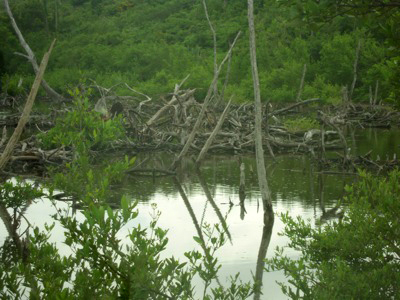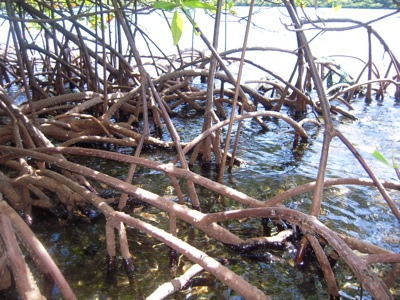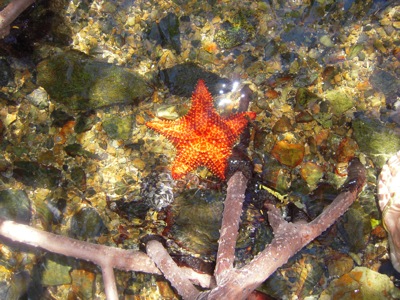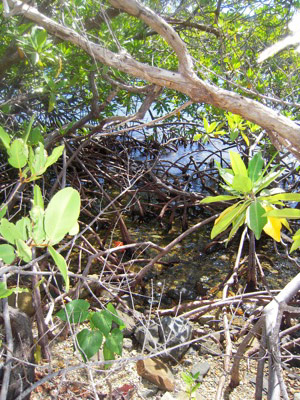
Preservation critical for mangroves
CRUZ BAY, U.S. Virgin Islands– Mangroves have been a common theme throughout my South Florida upbringing, but their need for preservation and vitality has not.
Weekends jet-skiing in the Florida Keys and vacationing in the Caribbean have allowed mangroves to hold one specific description in my memory bank…dark, slushy and creepy-looking tree-tangles that you don’t want to be around. It is a description obviously devised at a young age, yet one with proven staying power.
Although I could fully describe a mangrove, I knew little else about them. Their texture, the quicksand typed mush that surrounds them and their tangled wood and leaves of which resemble a child’s scribbles, interrupted occasionally by wildlife I could recall immediately. That, along with an incident that involved me thrown on the side of one at the age of 9 when my sisters Jet Ski trick went awry.
 |
The mangroves found at Lameshur Bay on St. John show the destruction hurricanes and boat docking can have on the island’s mangroves (Photos by Danielle Alvarez). |
Yet at the age of 22 and after almost four years of university scholarship under my belt, I had absolutely no idea of their composition or more Importantly, their immediate need for preservation throughout the Caribbean and the U.S Virgin Islands. That was until my feature writing class decided to visit the Virgin Islands National Park.
Little did I know I would be snorkeling alongside St. John’s most pristine mangroves with a newly found companion/ bus driver only weeks later.
So you may be thinking, what exactly are mangroves?
“Mangroves are those tree-water things that are swampy I think,” said Florida International University senior Jessica Dorado.
It seemed I was not the only South Floridian with a vague understanding.
According to a document released by U.S. Virgin Islands National Park Chief of Resource Management, Rafe Boulon titled “Fish Suffer from Mangrove Losses,” mangroves are classified as trees and shrubs that grow on tidal wetlands in the tropics that protect the shoreline, sea-grass beds and coral reefs and give food and sanctuary to marine life.
The document further detailed that mangroves have currently taken the back seat to the urgency in protecting the coral reefs, quoting United Kingdom marine biologist Dr. Peter Mumby to say, “‘Urgent action needs to be taken to preserve the mangroves if Caribbean fisheries and coral reefs are to be preserved’.”
“Many people just see the reefs as more important because of their beauty, they assume they are more delicate,” said St. John Island resident Marie Luso.
After arriving on St. John, with my primary mangrove research behind me, I met with Boulon, a lifelong resident of the U.S. Virgin Islands, whom, with his smiling eyes and passionate stance on preservation, quickly forced me to realize that one man’s mush is another’s masterpiece.
| The mangrove roots at Hurricane Hole stand firm and clean due to their protection by the hurricane mooring installation. |  |
Boulon currently works tirelessly alongside his team to preserve the island’s mangroves, efforts greatly assisted by the Virgin Islands Coral Reef National Monument, which was established in 2001 under the Clinton Administration.
According to Boulon, the importance of the island’s mangroves are paramount in that most of the fish found in coral reefs grow up and develop under their protection. In short, the mangroves are vital to the coral reefs, which are vital to our ecosystem.
“Mangroves are priority, as habitats for juvenile wildlife, they start everything,” he said.
Mangroves around the island have taken a hit in recent years.
“Fifty percent of all original mangroves on the Virgin Islands have been lost,” Boulon declared, noting that the very benches we sat on and surrounding massive concrete Visiting Center was originally a mangrove site.
One of the greatest causes of their destruction is island development. Unfortunately, much of the park, including the island’s mangroves, is private property, leaving the park’s authority with far less options in their efforts to enforce protection.
The island’s mangroves are also highly damaged in times of hurricanes or bad weather, but not all damage is natural. Locals often use the shelter of the mangroves to protect their boats from the crashing waves and high winds.
According to a U.S. Virgin Islands National Park Final Environmental Assessment released by Boulon, the bark exposed by the wear of ropes tied around them are often quickly exposed to parasite infestation and disease while many other pieces are simply broken off. Excess tackle, line and hardware are also often left behind to further tangle the mangroves roots and harm the juvenile wildlife.
 |
Starfish, juvenile fish and other wildlife find shelter in the mangroves at Hurricane Hole. |
It seems that the locals on the island are indeed better informed of the importance of the groves in comparison to many non-islanders yet do not make the preservation of them of utmost importance.
“Many of us do it just because it’s the safest place to have a boat during a storm,” said St. John resident Sean Serra, 37 in his explanation of why so many locals tie their boats to the mangroves.
I was able to observe the mangrove destruction on St. John first-hand during a drive through Lameshur Bay. According to a Restoration of Wetlands at Lameshur Bay report provided by Boulon, the area, originally consisting of red mangroves with shorelines patches of white mangroves and an upland perimeter of black mangroves was severely damaged by a series of hurricanes from 1989 through 1995.
With no light cast upon them, the mangroves looked sad, aged and dilapidated. They’re colors were all a dull shade of brown and gray and their surrounding quicksand both looked and smelled unnatural. Even the greenest leaves disgraced the color and lacked luster and broken pieces were found more abundant than those rooted together.
“These are the worst right here. Don’t they look so sad? It’s a shame but they are working to fix them,” said the park’s Chef of Visitor Education Paul A. Thomas.
According to the Lameshur report, the park set out in 2004 to begin restoration in the area through planting individual mangrove species and monitoring the mangrove seedling survival. My visit seemed to confirm slow progress, not to mention reignite those childhood mangrove memories.
Boulon proclaimed the most pristine mangroves of the island to be found at Hurricane Hole, located immediately east-northeast of Coral Bay. It is the preservation of this mangrove site in which Boulon feels is his greatest accomplishment.
Along with the generosity of numerous donors ($75,000 alone donated by county music signer Kenny Chesney), volunteers and in conjunction with the “Friends of the National Park,” a hurricane mooring system has been installed in, consisting of 120 moorings with which boaters can attach their vessels in place of using the actual mangroves in times of bad weather.
The installation in 2004 showed the islands first efforts to comply with the presidential proclamation (the Virgin Island Coral Reef National Monument) and its accompanying enabling legislation that prohibits anchoring in these sites. The mooring system is projected to accommodate approximately 100 vessels by the last installment, set to begin in December of 2008.
“This project really is my baby,’’ Boulon said.
| The mangroves found at Hurricane Hole on St. John are among the most pristine on the island. |  |
It would have been just downright disrespectful of me to have spent so much time with Boulon and not visit his “baby” while on the island, so I did just that. But of course, it’s not always as easy as jumping in a taxi and arriving at my destination, especially not on St. John.
To find a driver willing to take a single passenger all the way out to Hurricane Hole (about 40 minutes from the island’s ferry dropout), was the first task. After about 45 minutes of haggling in the blistering heat, I persuaded driver Leon Santos to take me, a deal solidified only by the Barack Obama sticker on my cell phone and the fact that I was from his favorite city, Miami.
I jumped in his Jeep, complete with a bumper sticker that read, “What happens in St. John stays in St. John” and arrived about an hour later, stopping twice to witness viewpoints Santos deemed “the best of the island.”
I found a natural entrance into the groves and walked in, holding only my swimmer’s mask, snorkel and a little courage (remember those childhood experiences I told you about).
I was completely alone with the massive mangrove area. Feeling the cool water and taking in the immense size of the brightly colored mangroves was almost overwhelming. With my head submerged it took a few seconds for my eyes to focus in the muddy waters but they soon adjusted to schools and schools of miniscule fish, swimming above and in between the thick and healthy wood.
An array of stones I hadn’t seen since a recent trip to the Greek Isles shone under the shallow clear water. A far cry from the scary tangles I classified mangroves as when I was a child. I also found several shockingly orange starfish that had made their home along with the other juvenile wildlife in the winding branches, a sight my driver, now in the water himself in true island fashion, said he hadn’t seen since he was a child.
“It’s important for us drivers to know more about the mangroves and educate as much as we can because we interact with so many people on a daily basis,” he said.
Post Hurricane Hole adventure, I understood the look in Boulon’s eyes that I took note of as he spoke of the progress of the mooring system and felt a tiny bit of honor having had alone time with the giant mangrove site.
Hurricane Hole is indeed pristine and exemplifies the efforts of the individuals like Boulon that work to save these vital shoreline barriers. The mangroves throughout the island are still in need of continued preservation yet the mooring system shows that the future of the groves is not all lost.
Those mushy, scary mangroves of my childhood now hold new weight and hopefully will continue to shed their reputation as being second in need to the coral reefs and find new shade and protection throughout the Virgin Islands.
Visiting Hurricane Hole:
- Arrange a Cruz Bay area taxi driver to stay with you or to return to pick you up at a certain time. Paying the driver extra to stick around while you visit the mangrove site might be your safest option as cell phone reception comes in and out on the island and drivers usually do not pass through the area.
- Just mention “Hurricane Hole” and any driver will know what you’re talking about.
- You will be able to find a driver near the Red Hook Ferry drop-off. You will most likely need to haggle with several to find one willing to make the trip.
- Allow yourself several hours for the trip (including an hour of snorkel time and time to get there and back)
- The round-trip should cost no more than $50 and many drivers will lower their prices if there are several people.
- Make sure to bring along anything you will need (snorkel gear, towel, water, food), as there is nothing available to purchase near the site.
- Find a natural entrance in the mangroves and be careful not to harm them while walking in the water … enjoy.

Comments are Closed